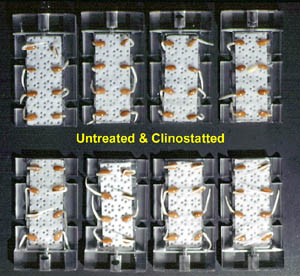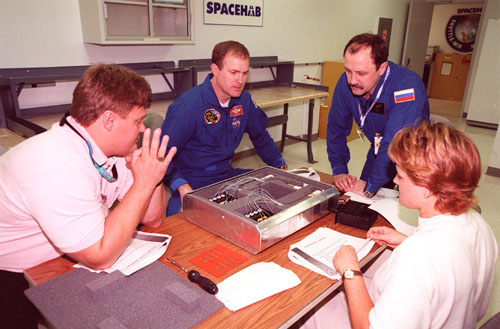STS-101
The precursor test on STS-101 was designed as a risk mitigation experiment. The objectives were to verify which quantity of water would allow optimal germination of flax seeds.This flight experiment evaluated the water delivery system and seed germination substrates. The flight was also used to verify a previously determined algorithm that calculated seedling (root) growth as a function of temperature. This precursor experiment was carried out in one half of a locker in the middeck of Atlantis. Seed germination requires a reservoir for water and substrate for germinating seeds. Mostly this is done with some type of germination paper. Based on previous flight experiments we used an absorbent plastic material (Crew wipes). However, the wetting agent used in this material had unexpected and serious side effects when seeds were germinated on a clinostat. |
|

|
 |
| Seed cassettes with flax seeds that germimated during clinotrotation. | Training session in preparation for STS-101 with (clockwise) Dan Shultz, Commander James Halsell, Mission Specialist Yuri Usachev of Russia and April Boody. They look at a biotube precursor set-up in front of them. |
|
Therefore, we needed to test special germination paper for its ability to absorb, distribute, and retain water in microgravity. When seeds are grown in the microgravity of space, the surface tension of water can cause (excess) water to form a thick layer around the surface of the seeds. This layer blocks oxygen which is needed for seed germination. If the barrier forms before the seeds germinate, they will die. Hence it was important to establish the optimal quantity of water. The flight also demonstrated seedling growth as a function of temperature in the limited volume of the sealed growth chambers. As a measurement for the natural tendency of roots to circumnutate we coated the edges of the seeds cassettes with a fluorochrome (calcofluor) that was designed to leave characteristic traces on the germinating roots. |
|
 |
![[STS-101 hardware]](images/101pl.jpg) |
| Sketch of the arrangement of the three MFC's in the foam bed showing the water delivery devices. Each device has eight pistons that delivered a preset amount of water. | The flight hardware is being prepared and assembled in a half-height locker. |
|
The payload consists of 24 seed cassettes housed in three Magnetic Field Chambers (MFCs), three syringe/tube mechanisms to deliver water and three passive temperature-recording devices. The MFCs were identical to the ones being used for the actual experiment on the BioTube MFA payload to expose plant materials to a magnetic field. However, aluminum blanks were flown instead of magnets, so the precursor experiment had no magnetic field. Twice during the flight, a crew member (Yuri Usachev) turned cranks on the three syringes to deliver water to the seed cassettes. The first watering occurred 30 to 36 hours before landing, the second 12 to 20 hours before landing. |
|